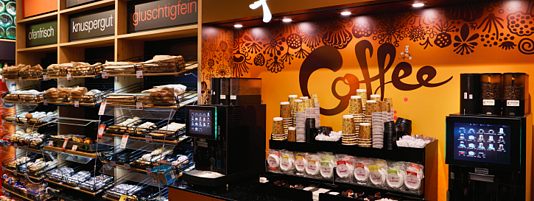The retail shopping experience has seen drastic changes over the past few years. Online sellers like Amazon and changes in consumer behavior are forcing retailers to rethink the role of their brick-and-mortar stores.
 The demand for printed point-of-purchase (POP) graphics may erode now that Amazon and changes in consumer behavior are
The demand for printed point-of-purchase (POP) graphics may erode now that Amazon and changes in consumer behavior are
forcing retailers to rethink the role of their brick-and-mortar stores. At a Migrolino convenience store in Zurich,
Bona Design Lab created graphics that reinforce a quality and freshness message across all categories of their retail proposition.
Online retailers are changing the way that products are stocked, priced, ordered and delivered. Take Amazon’s purchase of Whole Foods, which could play a role in developing their own Amazon Go brand and significantly change the landscape of the traditional grocery stores.
Brick-and-mortar retailers must evolve to respond to the growing popularity of online outlets, and must employ new technologies and innovations to expand their in-store offerings.
Retailers can explore brand experiences, in-store services, greater product education or out-of-home entertainment to draw consumers back into their store. They must offer something in the physical space that the shopper can’t get from e-commerce.
Examples of ways brick-and-mortar stores have tried this include 3D printers that produce customized products, having food and music or live entertainment in-store and presenting emotionally engaging VR experiences.
What physical retailers must understand about the changing wants and needs of consumers is the emergence of a new era of do-it-yourself shoppers who don’t necessarily want to interact with associates unless they need help, the increasing desire for more personalized customer experiences, an increase in popularity in smaller specialized shops and emerging approaches to product delivery that make obtaining your goods quicker and easier.
Print providers, and other brick-and-mortar retailers, must think beyond the traditional point of purchase offerings, and they must pay attention to trends in retail so that they can adapt to changing consumer behaviors and incorporate innovations into their processes.
Read more in the SGIA Journal Graphic Edition September/October 2017.